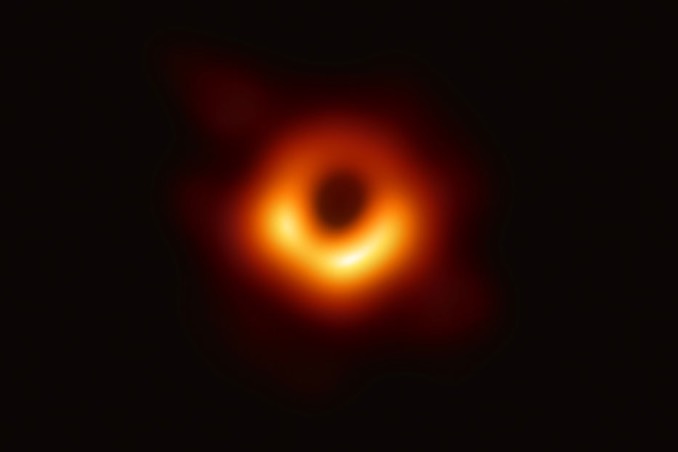At https://astronomynow.com/2019/04/10/virtual-telescope-captures-first-dir… … we are told that after years of observation and data analysis an international team of astronomers have capture images of a massive black hole – see below. Actually, it is the event horizon that can be seen, marking the boundary between normal space and the unknowable interior (of the black hole). The encircling ring of light is made up of photons from accelerated particles of gas and dust being pulled towards and around the event horizon. The image closely matches theory.
 … The same story is at www.sciencedaily.com/releases/2019/04/190410091028.htm … and refers to a special issue of Astrophysical Journal Letters (April 2019) which has published a series of articles on the image and how it came about. There are 4 images. The Event Horizon Telescope, so named as the event horizon was their target, involves an array of 8 radio telescopes. On any given day each telescope operates independently, observing radio waves emitted by cosmic objects. Black holes are said to be smaller but denser and darker than other radion waves – so to see one they have to use very short wave lengths, cutting through the clouds of material between earth and the black hole. However, when multiple radio telescopes are used they can operate as one large radio dish which means angular resolution is much greater.
… The same story is at www.sciencedaily.com/releases/2019/04/190410091028.htm … and refers to a special issue of Astrophysical Journal Letters (April 2019) which has published a series of articles on the image and how it came about. There are 4 images. The Event Horizon Telescope, so named as the event horizon was their target, involves an array of 8 radio telescopes. On any given day each telescope operates independently, observing radio waves emitted by cosmic objects. Black holes are said to be smaller but denser and darker than other radion waves – so to see one they have to use very short wave lengths, cutting through the clouds of material between earth and the black hole. However, when multiple radio telescopes are used they can operate as one large radio dish which means angular resolution is much greater.
At Prologion we have a more prosaic description of the findings – a sort of tongue in cheek scepticism. We are told that over the years several lines of indirect evidence have suggested the existence of black holes. It then says, the images are not pictures of a black hole, in spite of what the media are bleating. They are not even pictures. They are computer generated images that illustrate what radio telescopes detected at the centre of the M87 galaxy. Pictures are images that come from visible light. Radio telescopes, in this instance, have not detected visible light. They detect radio waves. Radio waves, however, are a form of light – but humans cannot see that wave length. Is he contradicting himself? Radio telescopes are radio receivers, he continues, of a kind. They receive radio waves from space and scientists use the data to infer what the radio telescope was pointing at. The array were looking at the centre of the M87 galaxy – and they were looking at it via a microwave (or very small radio waves). The image was constructed from a combination of 8 radio telescopes (as already noted) and whatever way you look at the images – they are impressive to say the least. What they detected, importantly, is exactly what one would predict for a black hole that is surrounded by hot gas (or plasma).
The Prologion author continues – while I consider these images as excellent evidence of a black hole we must remember the data came from 8 separate telescopes (which was combined into a single image). As a result of this the data must be added together with a mathematical model – and that model necessarily involves assumptions. It is possible that what we are seeing is an artifact of the model.
See http://blog.drwile.com/best-evidence-yet-for-a-black-hole/
